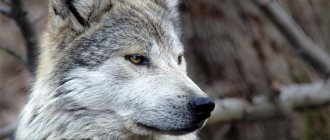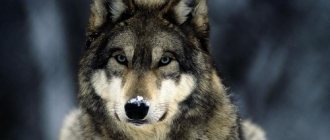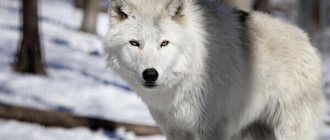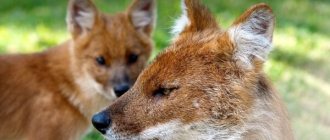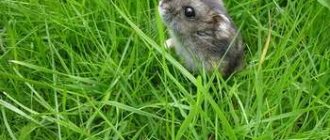Wolves are ancient predators of the canine family, whose length including tail reaches 160 cm and height - 90 cm. An ordinary gray wolf can weigh as much as an adult, up to 60 kilograms or more. The largest population of wolves today is observed in northern latitudes. And although the number of these predators is decreasing every year, hunting them is allowed in most areas. The reason for this is the danger for residents of remote villages and especially for livestock, which wild wolves love to feast on.
Wolves feed on the living flesh of animals that they were able to catch during the hunt. But if hunting does not lead to success for a long time or there are very few ungulates in their habitat, they will not disdain carrion. The diet of wolves is based on ungulates, which include roe deer, wild boars, and moose. In addition to these animals, wolves also hunt other animals:
- domestic and wild geese, chickens (including egg laying and chicks);
- domesticated and raccoon dogs;
- rodents (gophers, voles, hamsters);
- reptiles (toads and frogs, snakes and lizards);
- hares and foxes;
- waterfowl;
- badgers, ferrets, marmots.
Wolves love to attack weak and sick animals and finish them off. Even a bear during hibernation can become prey for these predators. If it is not immediately possible to eat the caught animal, then the wolves hide the prey and then return to it. In times of hunger, they like to feed on carrion thrown out from the seas and oceans (seals), as well as the corpses of animals found in a forest or field.
Wolves often feed on a variety of berries and fruits, and mushrooms. This is caused by a large need for water, which is sometimes difficult to satisfy. Watermelons and melons are especially helpful in quenching thirst if the wolf manages to find them on farms.
Cannibalism is common among wolves, when sick and wounded animals are killed by stronger and healthier individuals. This happens in those seasons when it is not possible to obtain food in the usual way, so the flock has to starve.
Description
The wolf is quite large in size. Depending on the geographical location of the animal’s habitat, they can vary within certain ranges. The average weight of a predator is about 50 kilograms, but in Alaska and Siberia it can reach 77 kilograms. In rare cases, their weight can exceed 90 kilograms. The smallest subspecies is the Arabian wolf, which can weigh only 10 kilograms.
In appearance, this animal resembles a large dog with pointed ears. The male is always larger than the female. The color of a wolf's coat may vary depending on the natural area in which it lives. Sometimes the color is mixed. The animal's fur is very thick with dense undercoat, which gives the wolf a visually larger size than it actually is.
The tail of this animal is thicker and longer than that of a dog. By its position one can judge the mood of the animal and what status it occupies in the pack.
Vision is the wolf's weakest sense organ. His hearing and sense of smell are most developed. Combined with good physical characteristics, this makes it a very dangerous predator.
Appearance
The wolf (Canis lupus) is the largest representative of the canine family. This is a magnificent, well-proportioned animal with slender, strong legs, a powerful head and neck, and a strongly elongated muzzle framed by whiskers. Males are slightly larger than females and have a larger forehead (photo 1). The teeth and jaws of these predators are so strong that they can crush the largest bones (for example, the femur of an elk) (photo 11). Wolves' fur is thick, quite long and consists of two layers. The first layer is hard guard hairs that repel water and dirt, the second layer is downy undercoat and has excellent heat-insulating properties. Thanks to such fur, the wolf almost does not freeze or get wet - for example, in winter he can sleep peacefully in the snow (photo 2, 3).
Lifestyle
Wolves live in packs that have a strict hierarchy. They usually form groups of 10-30 individuals. The leader monitors discipline, distributes responsibilities and divides the spoils. Each pack is dominated by a dominant pair. Even the weakest members of the community can count on protection and a share of the spoils.
The wolf's voice has a wide range. Each sound has many variations. Thanks to this, wolves can transmit various information to each other over a very long distance. They are even able to warn their fellow tribesmen about the approach of a person. The signal for an attack is usually given by the leader. This sound is reminiscent of the angry growl of an angry dog. Some people living in close proximity to nature have learned to distinguish the language of wolves.
Habitat
In the past, the wolf's habitat was similar to that of humans. Today, their living environment has shrunk somewhat. Currently, the wolf can be found in North America, Europe and Asia. In Russia, this animal is distributed throughout the entire territory, absent only in Sakhalin and the Kuril Islands.
The wolf can be found in any area, but it still prefers the steppe, forest-steppe, semi-desert and tundra. Often this predatory animal settles close to human habitations, avoiding dense forest areas.
Wolves were once among the most common land animals
The original range of wolves consisted of most of the Northern Hemisphere - from the Arctic to 20°S latitude, which runs through south-central Mexico, northern Africa and southern Asia. However, due to habitat destruction, environmental change, human persecution, and other barriers to population growth, wolves are currently found only in a few areas of the United States, Alaska, Canada, Eurasia, and Mexico (small populations). They occupy a wide variety of habitats, from arctic tundra and forests to prairies and arid landscapes. They cannot be found only in deserts and tropical forests.
Breeding offspring
During the mating season, males fight fiercely for female wolves. These animals form a pair for life. The next stage of the mating season is the creation of housing.
To breed, wolves set up dens. For this purpose, mountain crevices and burrows of other animals are used; sometimes the wolf digs out the dwelling on its own. The female is constantly present here during the period of raising offspring. As a rule, in one season, wolves give birth to one offspring in the amount of 3 to 13 wolf cubs. Wolves prefer to hunt away from their lair. After the wolf cubs grow up, the family leaves their home and leads a nomadic lifestyle, setting up resting places in different shelters.
What does it eat?
The wolf is a typical predator. It obtains its food through pursuit and attack. What does a wolf eat in the wild? The basis of its diet are ungulates. In the absence of such, animals can attack livestock and dogs. They can also feed on small animals and rodents. Wolves hunt large prey in packs, and small prey alone. They prefer to attack weak and sick animals.
What else do wolves eat? Often these predators even hunt birds. In case of hunger, they can eat their wounded relative. They can also feed on animal carcasses. In times of hunger, they eat reptiles and even plant foods.
What do wolves eat in winter? During the cold season it is very difficult to find food. At this time, predators become especially bloodthirsty. So, what does a wolf eat in winter? Their diet does not change much in the cold, but they prefer to hunt in packs at this time of year. Weaker individuals try to get closer to a person’s home in the hope of getting livestock.
Lifestyle and habits
This predator mainly obtains food by hunting. As a hunter he is well equipped. At a speed of 10 km/h he can run for a very long time without getting tired. Capable of reaching speeds of up to 65 km/h. Small membranes between its toes help it move quickly in the snow.
Possessing a very developed sense of smell, the predator is able to smell prey at a distance of more than a kilometer. Vision and hearing are well developed, but the sense of smell is weaker.
These predators prefer to live in packs. The pack is led by an alpha male wolf and an alpha female. Each individual in the flock performs a specific social role. The target of a pack's hunt is always a large animal.
In the summer the flock breaks up, because during this period they can feed themselves individually.
There are wild wolves that prefer to live separately from the pack. They hunt from ambush.
When hunting in a pack, several individuals can play the role of beaters who lead the game to an ambush. However, in general, predators, taking turns replacing each other, force the prey to expend energy faster. By scaring the herd, they accurately identify weakened or sick animals, which they continue to hunt.
Predatory wolves use a prolonged howl to unite the pack and scare away strangers. Like other large predators, they actively mark their territory.
Hunting
Wolves forage for food mainly at night. They can chase prey for a long time until it becomes exhausted. The wolf is well developed mentally. This is expressed in hunting methods and methods of protection. Wolves approach their prey unnoticed. When attacking game, each member of the pack performs its own function.
They use various cunning tactics to do this. For example, they drive deer to a cliff, from which the animals are afraid to jump and fall into the clutches of a predator. They try to lure moose to snowy places or to bodies of water covered with ice. Here the victim falls through and cannot escape. A hungry wolf can eat about 12 kg of food at one time. He buries the remains of his prey and returns for it in times of famine.
Wolves gradually teach their cubs to forage for food. Initially, the wolf cubs watch their elders and learn from them all the subtleties and tactics of hunting. They first take part in this activity at the age of six months. Adhering to strict discipline, kids learn skills from their elders.
Captivity
Currently, many are wondering whether it is possible to keep a wolf at home. This is possible if you follow certain rules. The living conditions of this predator in captivity may be different. For example, zoos, wildlife parks, or an aviary in a residential building. What does a wolf eat in such conditions? Depending on the environment in which it is kept, the animal’s diet is also selected.
The wildlife park is the closest to the wolf's natural habitat. Every week a carcass of a large animal is given out, part of which is immediately eaten by predators, and part of which is buried by them for later.
At the zoo, the wolf is fed daily, six times a week, and on the seventh day the predator goes hungry. The animal is given two to three kilograms of meat for bones, vegetables and protein-mineral food.
What does a wolf kept in an enclosure eat? His diet usually consists of dry dog food, cereal and meat. Feeding is done twice a day. The amount of food depends on the weight of the wolf. It is necessary to ensure that the animal always has clean water. You can diversify a wolf's diet with fermented milk products and eggs. It is advisable to enrich the diet with vitamins and minerals.
Wolves are unpretentious animals. They can eat whatever their owner provides. Nevertheless, you need to carefully monitor the condition of the animal, its well-being and health. In case of any deviations from the norm, the animal must be shown to a veterinarian.
If you want to get a predator, you need to keep in mind that it is better to take it from a nursery. You cannot take a wolf cub left without parents home after a hunt. This is a wild animal that is dangerous to humans.
We learned in detail about what a wolf eats in the wild and in captivity. Why is a meeting between a man and a wolf dangerous? Let's figure it out further.
Puppies nutrition
Wolf cubs weighing 300–500 g, covered with soft grayish-brown fur, are born blind and with closed ear canals, gaining sight in 9–12 days. Their milk teeth erupt between the second and fourth weeks, and 3-week-old puppies crawl out of the den on their own. At the same age, they are left alone while the older ones hunt, and by 1.5 months they are able to run away and hide in case of danger.
The she-wolf feeds the brood with milk for up to 1.5 months, and she herself eats what the male brings: caught game or belching in the form of semi-digested meat. Wolf cubs that have reached 3-4 weeks of age eat the burps themselves, leaving crumbs for the mother.
Important! Zoologists suggest that feeding puppies burps (semi-digested pulp) is due to a lack of digestive enzymes called peptidases. It was noticed that artificially fed wolf cubs that did not receive belching were noticeably delayed in development and growth, and also suffered from rickets.
At 3–4 months, the young no longer need to burp and begin to feed on small animals, which are dragged into the den by their parents. Lactating wolves become very exhausted in the summer, while puppies quickly gain weight, especially in the first 4 months of life. During this period, their weight increases approximately 30 times (from 0.35–0.45 kg to 14–15 kg). The average young wolf weighs 16–17 kg by the age of 6 months.
After the wolf cubs are strong enough, adults teach them to catch and kill game, bringing it to the den alive, albeit battered. By mid-summer, seasoned males are already leading the young to the slaughtered animals, but more intensive training begins later. In August, grown-up wolves try to catch rodents and other small things, and in September they become full participants in the hunt for ungulates.
Return to content
Is a wolf dangerous for humans?
Usually this beast does not like to attack people, but this depends on many factors. Attacks on people are the exception rather than the rule. But don't underestimate the danger. If wolves are in a pack and are hungry, an attack on a person is inevitable.
A hunter is more likely to become a victim of a predator than an ordinary mushroom picker or tourist. This is due to the fact that wolves are excellent psychologists and feel danger to themselves. And the presence of a weapon behind a person’s back finally convinces the beast of his intentions. If wolves see a tired traveler, they immediately sense his vulnerability, form a pack and attack.
Taking into account the high degree of danger of a wolf for humans, it is worth thinking several times before deciding to keep a wild animal at home.
